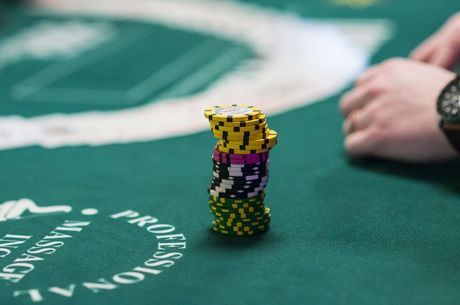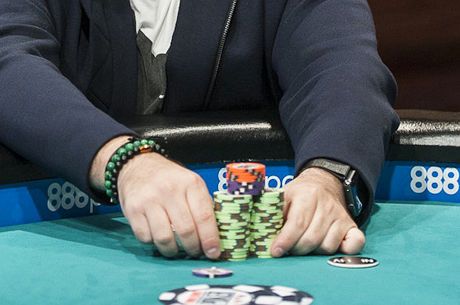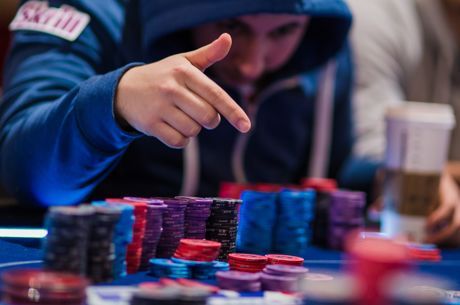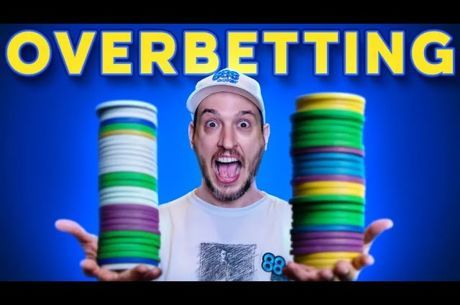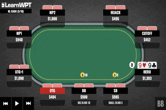His and Hers Poker: Betting Thin to Win
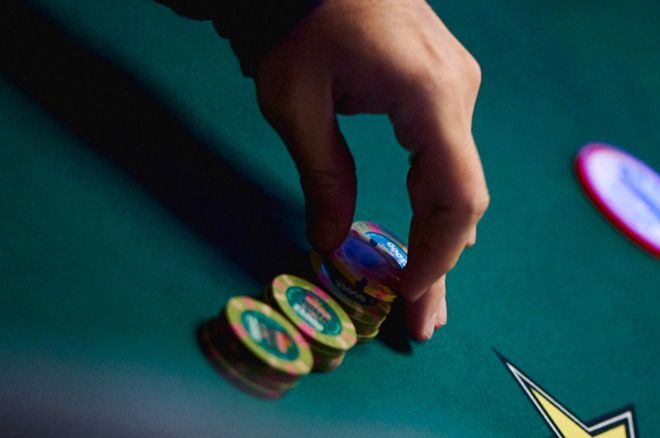
Hello, Poker Friends! This week we are going to examine an often overlooked part of good exploitative play — extremely thin value betting.
The Table and Villain(s)
Hero (Matt) is at a $2/$5 table at the Borgata which is mostly filled with loose-passive recreational players. The Main Villain in this hand falls into that category. The only postflop raises he has made thus far have been shown to be with very strong value holdings. Villain is in the first middle position seat for this hand.
Effective Stacks: ~$700 (Villain).
Preflop
Action
The player under the gun limps, as does the Villain from his spot in middle position. It folds to Hero in the cutoff. Hero has J♥10♥ and opens to $30 over the two limps. It folds to the big blind who calls. Both of the initial limpers also call.
Analysis
If you find yourself limping behind in spots like this to "see a cheap flop," that is an element of your game that you should quickly adjust.
Many players who limp behind with mid-range suited connectors from late position do so because they have bad memories of flopping top pair with something like J♥10♥ and losing a big pot to someone who limp-called with KxJx-offsuit. The solution to that dilemma is not to limp behind with lower rank holdings. It is instead to be more cautious in how you play top pair with weak kickers.
On that note, we should be clear that the main reason you are opening with J♥10♥ is not to win a mid-sized pot with top pair, but to win a massive pot with a flush or straight. In other words, you are doing it to inflate the pot size with an excellent drawing hand. To a good player, there should be nothing more depressing than dragging a modest-sized pot at showdown with a flush.
Flop
Action
With $122 in the pot, the flop comes 9♣8♦2♥. All players check to Hero, who bets $55. The Villain is the only caller.
Analysis
One of the first things we teach new students is to continuation bet flops in accordance with the board texture, not your individual holding. This is a naturally balancing technique which serves all portions of your range well.
We should use a rather small sizing on this dry board. If we had an excellent value holding like 9x9x or AxAx, we would want to incentivize calls by keeping our sizing small. Conversely, when we have a drawing hand like J♥10♥, our main goal is not to hit a straight, but to take down the pot on the flop for as cheap as possible.
Since there are very few hands which interact with this flop, we shouldn't need to bet much to fold out the vast bulk of hands which are currently beating us.
Turn
Action
The pot is now $232 and the turn brings the 10♦, for a turn board of 9♣8♦2♥10♦. Villain checks. Hero bets $70. Villain calls.
Analysis
This turn should be played very differently against aggressive and passive opponents. Against an aggressive opponent, this would be an almost certain check back which would serve two purposes. First, it would strengthen our checking range by giving us a top pair hand to use as a bluff catcher on a blank river. Second, checking would avoid putting us in a sick spot when the aggressive player puts in a check-raise with the number of combo draws which the 10♦ just generated in his range.
Against a passive player, all of this goes out the window. We are only left to consider how to get maximum value from our opponent. Here, there is certainly value to be had. There are still worse one-pair hands which will call off for the right sizing. Also, we still have drawing equity when we are behind. However, the 10♦ did improve quite a bit of Villain's calling range from the flop. Therefore we need to be cautious and keep our sizing small to ensure that we get called by worse a sufficient amount of the time.
We have spoken with players who would advocate a much larger bet sizing in this spot. Their reasoning is that many recreational players are so bad that they will blindly call off three streets for a half-pot sizing with top pair from the flop.
That kind of thinking will get you burned. Recreational players are not idiots. They can see the scary implications of the 10♦ just as well as anyone. That will necessarily constrict their calling range. Your task is to make sure they do so improperly. In other words, size your bet so that your opponent continues to call off too wide. Here, that means sizing in order to both ensure calls from holdings like Ax9x-offsuit and to tempt in hands like Kx8x-suited.
To be clear, this sizing should only be used against a notably passive player such as this Villain. It is a highly exploitative line which is just as easily counter-exploited. Even some middle-of-the-road players will sniff out this bet for what it is and put in a raise with their combo draws. We need to know that there is next to zero danger of a bluff-raise before we attempt this thin value bet.
River
Action
With $372 in the pot, the river is the 6♦, making the completed board 9♣8♦2♥10♦6♦. Villain checks. Hero bets $75. Villain thinks for a few seconds before making a shrugging call. Hero shows his J♥10♥ and Villain mucks his hand.
Analysis
Would you normally check back this river? Be honest. Many players would do so, even competent low stakes regulars. If you want to spot extremely good players at your table, don't just look for flashy hero calls or sick bluffs. Look for super-thin value bets. These players know how to boost their bottom line by squeezing every last bit of value from their opponents.
By definition, a river value bet is positive EV if it has greater than 50 percent equity against the opponent's calling range. That can initially seem daunting on this board. The trick is to price so small that we keep in a sufficient number of one-pair hands which we still have beat to offset the large number of hands which are now beating us.
To be clear, we are only attempting this because of Villain's passivity and another very important factor: Villain's initial limp-call. If Villain doesn't have holdings like Kx8x-suited and Ax9x-offsuit, then making a positive EV value bet here becomes impossible for any sizing. Villain simply can't call us off with something worse if he never has worse in his range.
However, after a limp-call preflop and two postflop calls at a small sizing, it is plausible to think that Villain has enough one-pair combos to make this a good value bet. Villain's calling range to a $75 bet is certainly an open question, but putting a likely range into an equity calculator shows 54 percent equity for J♥10♥.
The Takeaway
Thin value betting is one of the hallmarks of all very strong players, so make sure that you incorporate it into your game! The best targets are highly passive players who will rarely (if ever) punish small bet sizing with a counter-exploitative bluff-raise.
His and Hers Poker is a free, weekly strategy podcast hosted by Matt and Tracey Waldt. They are a married couple who play live cash games on the East Coast. Their podcast focuses on providing practical advice about hand reading, with an emphasis on how to identify and exploit the common leaks and imbalances of low-stakes players. His and Hers Poker can be found on iTunes, Google Play and other podcast services. For more information, and to subscribe, please visit hisandherspoker.com.

